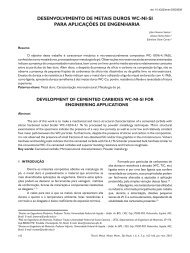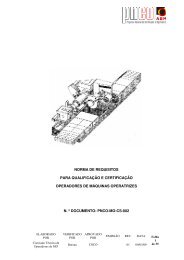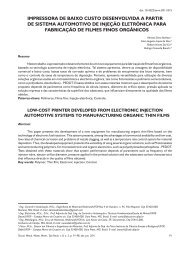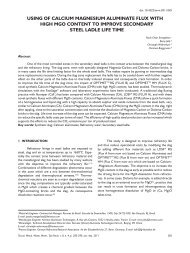EffEct of iron on EnErGY conSUMPtion AnD cUrrEnt ... - ABM
EffEct of iron on EnErGY conSUMPtion AnD cUrrEnt ... - ABM
EffEct of iron on EnErGY conSUMPtion AnD cUrrEnt ... - ABM
Create successful ePaper yourself
Turn your PDF publications into a flip-book with our unique Google optimized e-Paper software.
Figure 1 shows that for the acid electrolyte without <str<strong>on</strong>g>ir<strong>on</strong></str<strong>on</strong>g>,the BC porti<strong>on</strong> decreases, indicating an accelerati<strong>on</strong> <str<strong>on</strong>g>of</str<strong>on</strong>g> thecathodic process. In the presence <str<strong>on</strong>g>of</str<strong>on</strong>g> Fe, the nucleati<strong>on</strong>/electrocrystallizati<strong>on</strong>overpotential (BC porti<strong>on</strong>) increases, meaning thatzinc depositi<strong>on</strong> becomes more difficult in the presence <str<strong>on</strong>g>of</str<strong>on</strong>g> Fe. Theadditi<strong>on</strong> <str<strong>on</strong>g>of</str<strong>on</strong>g> <str<strong>on</strong>g>ir<strong>on</strong></str<strong>on</strong>g> to the acid electrolyte produces an inhibiti<strong>on</strong> <str<strong>on</strong>g>of</str<strong>on</strong>g>the zinc depositi<strong>on</strong>, which can be c<strong>on</strong>firmed by the results <str<strong>on</strong>g>of</str<strong>on</strong>g> electrodepositedzinc mass as shown in Table 2. The inhibiti<strong>on</strong> <str<strong>on</strong>g>of</str<strong>on</strong>g> zincreducti<strong>on</strong> is due to the reducti<strong>on</strong> <str<strong>on</strong>g>of</str<strong>on</strong>g> ferric i<strong>on</strong>s, which is moresignificant as the <str<strong>on</strong>g>ir<strong>on</strong></str<strong>on</strong>g> c<strong>on</strong>tent increases. The ferric i<strong>on</strong>s wereattracted to cathode and competed with zinc i<strong>on</strong>s in the reducti<strong>on</strong>process.3.3 Morphology3.3.1 Acid electrolyteMorphology <str<strong>on</strong>g>of</str<strong>on</strong>g> electrodeposited zinc usingacid electrolyte shows hexag<strong>on</strong>al crystals <str<strong>on</strong>g>of</str<strong>on</strong>g> zinc,deposited as multilayer, as shown in Figure 3,which presents a micrograph <str<strong>on</strong>g>of</str<strong>on</strong>g> surface <str<strong>on</strong>g>of</str<strong>on</strong>g> electrodepositedzinc using an acid electrolyte with15 mg.L -1 Fe.3.2.2 Electrolyte <str<strong>on</strong>g>of</str<strong>on</strong>g> zinc sulfateThe linear sweep curves that represent cathodic and anodicreacti<strong>on</strong>s for the zinc sulfate electrolyte are shown in Figure 2.The electrolyte without <str<strong>on</strong>g>ir<strong>on</strong></str<strong>on</strong>g> additi<strong>on</strong> shows a lowestcurrent density <str<strong>on</strong>g>of</str<strong>on</strong>g> anodic peak. In this case, the zinc mass electrodepositedfrom an electrolyte without <str<strong>on</strong>g>ir<strong>on</strong></str<strong>on</strong>g> additi<strong>on</strong> was thesame mass deposited from an electrolyte with <str<strong>on</strong>g>ir<strong>on</strong></str<strong>on</strong>g> additi<strong>on</strong>. Atendency <str<strong>on</strong>g>of</str<strong>on</strong>g> formati<strong>on</strong> <str<strong>on</strong>g>of</str<strong>on</strong>g> a new anodic peak is observed at –50 mV(Ag/AgCl), and can be associated to the <str<strong>on</strong>g>ir<strong>on</strong></str<strong>on</strong>g> dissoluti<strong>on</strong> accordingto EDS results. The EDS analysis <str<strong>on</strong>g>of</str<strong>on</strong>g> the electrodeposited zincshows the presence <str<strong>on</strong>g>of</str<strong>on</strong>g> <str<strong>on</strong>g>ir<strong>on</strong></str<strong>on</strong>g> in deposited zinc, for the electrolysisusing the zinc sulfate with 10 and 15 mg.L -1 Fe.Figure 3. Micrograph <str<strong>on</strong>g>of</str<strong>on</strong>g> surface <str<strong>on</strong>g>of</str<strong>on</strong>g> electrodeposited zincusing an acid electrolyte with 15 mg.L -1 Fe.EDS analysis <str<strong>on</strong>g>of</str<strong>on</strong>g> the electrodeposited zincshows the presence <str<strong>on</strong>g>of</str<strong>on</strong>g> <str<strong>on</strong>g>ir<strong>on</strong></str<strong>on</strong>g> <strong>on</strong> deposited zincusing the acid electrolyte without <str<strong>on</strong>g>ir<strong>on</strong></str<strong>on</strong>g> additi<strong>on</strong>(0.25 wt% Fe), and with 10 mg.L -1 Fe additi<strong>on</strong>(0.11 wt% Fe). The acid industrial electrolytec<strong>on</strong>tained <str<strong>on</strong>g>ir<strong>on</strong></str<strong>on</strong>g> as impurity before <str<strong>on</strong>g>ir<strong>on</strong></str<strong>on</strong>g> additi<strong>on</strong>,according to Table 1. The electrodeposited zincusing the acid electrolyte without <str<strong>on</strong>g>ir<strong>on</strong></str<strong>on</strong>g> additi<strong>on</strong>showed a higher mass than the deposited zincobtained with acid electrolyte with additi<strong>on</strong> <str<strong>on</strong>g>of</str<strong>on</strong>g>5 and 15 mg.L -1 Fe.The porosity <str<strong>on</strong>g>of</str<strong>on</strong>g> electrodeposited zincdoes not change, or decreases with <str<strong>on</strong>g>ir<strong>on</strong></str<strong>on</strong>g> additi<strong>on</strong>in acid electrolyte as shown in Table 4.Figure 2. Linear sweep curves that represents the <strong>on</strong>set <str<strong>on</strong>g>of</str<strong>on</strong>g> cathodic depositi<strong>on</strong>and redissoluti<strong>on</strong> <str<strong>on</strong>g>of</str<strong>on</strong>g> deposited zinc are shown for the zinc sulfate soluti<strong>on</strong>without <str<strong>on</strong>g>ir<strong>on</strong></str<strong>on</strong>g> additi<strong>on</strong> and with 5 mg.L -1 , 10 mg.L -1 and 15 mg.L -1 Fe.The BC regi<strong>on</strong>s in the voltammograms shown in Figure 2 aresimilar in length, indicating a same facility <str<strong>on</strong>g>of</str<strong>on</strong>g> the cathodic process.The values <str<strong>on</strong>g>of</str<strong>on</strong>g> electrodeposited zinc mass <str<strong>on</strong>g>of</str<strong>on</strong>g> the zinc sulfate electrolyteswithout <str<strong>on</strong>g>ir<strong>on</strong></str<strong>on</strong>g>, and with 5, 10, and 15 mg.L -1 Fe are similar,and are according to these results.Table 4. Porosity <str<strong>on</strong>g>of</str<strong>on</strong>g> the electrodeposited zincElectrolyte Porosity (%)60 g/L Zn without Fe 0.3360 g/L Zn with 5 mg/L <str<strong>on</strong>g>of</str<strong>on</strong>g> Fe 0.7560 g/L Zn with 10 mg/L <str<strong>on</strong>g>of</str<strong>on</strong>g> Fe 0.7360 g/L Zn with 15 mg/L <str<strong>on</strong>g>of</str<strong>on</strong>g> Fe 0.53Acid electrolyte 0.65Acid electrolyte with 5 mg/L <str<strong>on</strong>g>of</str<strong>on</strong>g> Fe 0.63Acid electrolyte with 10 mg/L <str<strong>on</strong>g>of</str<strong>on</strong>g> Fe 0.38Acid electrolyte with 15 mg/L <str<strong>on</strong>g>of</str<strong>on</strong>g> Fe 0.5664 Tecnol. Metal. Mater. Miner., São Paulo, v. 7, n. 1-2, p. 61-66, jul.-dez. 2010

















